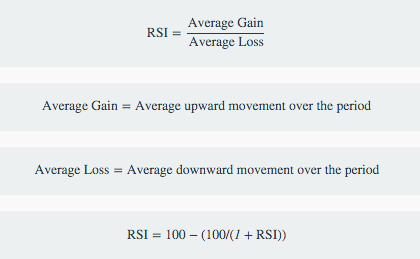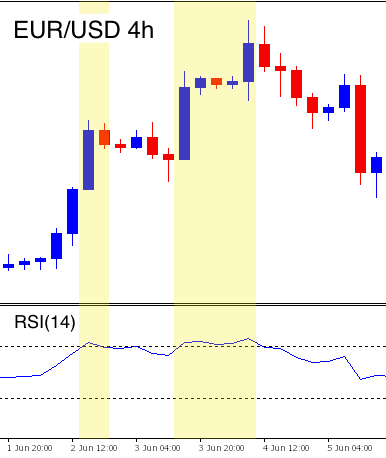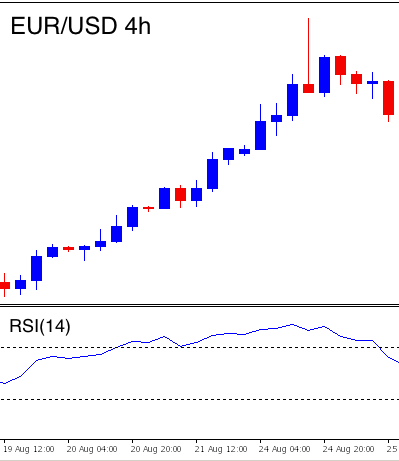In this article we’ll cover three of the most common technical indicators, the Relative Strength Index (RSI), Bollinger Bands, as well as a Simple Moving Average Cross (SMA Cross), and how they can be used to identify different market conditions.
Let’s get started!
RSI
The RSI is one of the most widely-known technical indicators with many traders using it both to identify overbought and oversold conditions as well as to measure the strength of a trend. We’ll explore both applications but let’s first look at the underlying calculation:

So as the RS gets larger, i.e. the Average Gains grow larger than the Average Losses, the second part of the equation approaches 0 and the denominator approaches infinity, effectively leading to:
And as the RS gets smaller, i.e. the Average Gains are smaller than the Average Losses, the RSI approaches 0:
RSI as a Counter-Trend Indicator
Conventional wisdom uses the RSI as “Over 70 = Overbought” and “Under 30 = Oversold”. But what do those numbers really mean?
The 70 mark is reached when the Average Gains are 2.33 larger than the Average Losses (the opposite being true for the 30 RSI value). The logic is that anytime the Average Gains are that much larger than the average losses the market is due for a correction.
Depending on the asset and timeframe you are trading, 2.33 times larger may be enough but it could just as easily signify a growing trend. If you were looking for a more pronounced difference, such as the Average Gains being 4 times larger than the Average Losses, you would want to look for an RSI value of 80 (or 20 to go long). This leads to a much more pronounced reversion from the mean but could also signify a strong breakout.
RSI as a Trend-Following Indicator
The RSI, looking at the underlying calculation, is measuring the strength of a trend by comparing the size of the upward movements to the size of downward movements. As the upward movements become larger than the downward movements we are thought to be in an uptrend. Can it be that simple?
Not quite. Let’s take the case where the RSI is at 60, meaning the Average Gains are 1.5 times larger than the Average Losses. This seems like the market could be in a moderate bullish trend. But what if the previous RSI value was 65? So the Average Gains used to be almost 2 times the Average Losses but they have been getting smaller. The trend would appear to be diminishing.
In order to use the RSI as a Trend-Following indicator, you want to look at where it is compared to its most recent range. For example, if the RSI has ranged between 55 and 45 for the last week and suddenly breaks above 60, there’s a good chance you are in an uptrend.
To do this we can use the Stochastic RSI. The Stochastic RSI applies the Stochastic formula to the RSI to give you a sense of where the current value is relative to the most recent range:

High Stochastic RSI values mean that the RSI is in the top of its range, signaling a potential bullish trend, while low Stochastic RSI values show that it is in the bottom of its range and demonstrate a bearish trend.
Editors’ Picks
EUR/USD edges lower toward 1.0700 post-US PCE

EUR/USD stays under modest bearish pressure but manages to hold above 1.0700 in the American session on Friday. The US Dollar (USD) gathers strength against its rivals after the stronger-than-forecast PCE inflation data, not allowing the pair to gain traction.
GBP/USD retreats to 1.2500 on renewed USD strength

GBP/USD lost its traction and turned negative on the day near 1.2500. Following the stronger-than-expected PCE inflation readings from the US, the USD stays resilient and makes it difficult for the pair to gather recovery momentum.
Gold struggles to hold above $2,350 following US inflation

Gold turned south and declined toward $2,340, erasing a large portion of its daily gains, as the USD benefited from PCE inflation data. The benchmark 10-year US yield, however, stays in negative territory and helps XAU/USD limit its losses.
Bitcoin Weekly Forecast: BTC’s next breakout could propel it to $80,000 Premium

Bitcoin’s recent price consolidation could be nearing its end as technical indicators and on-chain metrics suggest a potential upward breakout. However, this move would not be straightforward and could punish impatient investors.
Week ahead – Hawkish risk as Fed and NFP on tap, Eurozone data eyed too

Fed meets on Wednesday as US inflation stays elevated. Will Friday’s jobs report bring relief or more angst for the markets? Eurozone flash GDP and CPI numbers in focus for the Euro.
RECOMMENDED LESSONS
Making money in forex is easy if you know how the bankers trade!
Discover how to make money in forex is easy if you know how the bankers trade!
5 Forex News Events You Need To Know
In the fast moving world of currency markets, it is extremely important for new traders to know the list of important forex news...
Top 10 Chart Patterns Every Trader Should Know
Chart patterns are one of the most effective trading tools for a trader. They are pure price-action, and form on the basis of underlying buying and...
7 Ways to Avoid Forex Scams
The forex industry is recently seeing more and more scams. Here are 7 ways to avoid losing your money in such scams: Forex scams are becoming frequent. Michael Greenberg reports on luxurious expenses, including a submarine bought from the money taken from forex traders. Here’s another report of a forex fraud. So, how can we avoid falling in such forex scams?
What Are the 10 Fatal Mistakes Traders Make
Trading is exciting. Trading is hard. Trading is extremely hard. Some say that it takes more than 10,000 hours to master. Others believe that trading is the way to quick riches. They might be both wrong. What is important to know that no matter how experienced you are, mistakes will be part of the trading process.

